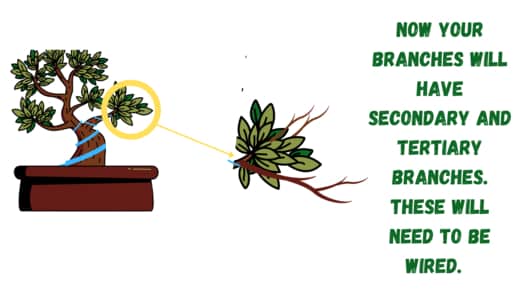This website is supported by its readers. If you click one of my links I may earn a commission. I am also a participant in the Amazon affiliates program and I will also earn a commission from qualified purchases.
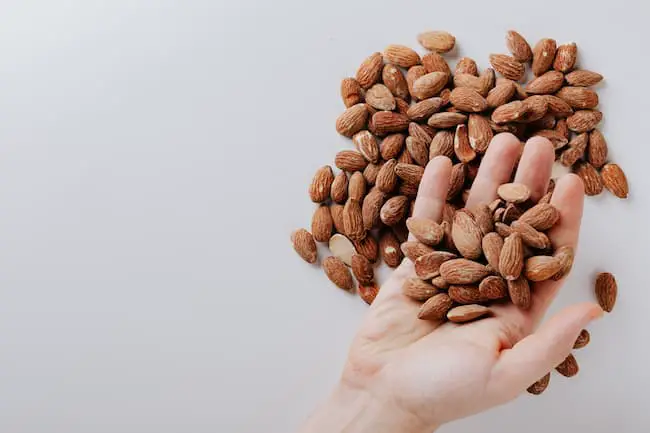
So recently, I’ve been reading up a fair bit about almond trees and was blown away by the fact that these trees have been grown in the UK since the 16th century. As such, being the bonsai enthusiast I am, I wondered if you could grow an almond bonsai tree.
You can transform almond trees into bonsai trees. To bonsai an almond tree, ensure it is the right time of year and decide on the style and size of your tree. Repot/plant the tree in an adequate size pot, develop the trunk, and then wire and prune to achieve your desired look.
So what is the exact step-by-step process of watering your bonsai tree? And what are the advantages and disadvantages of growing an almond bonsai tree? Keep reading to find out more!
Just a quick heads up, over the past three years of running Plantpaladin, hundreds of people have asked for product recommendations. As such, You can find my favorite indoor bonsai tree here (link takes you to Bonsaiboy), my favorite outdoor bonsai tree (link takes you to Bonsaiboy), or have a look at all the products I recommend here.
How to grow an almond bonsai tree?
Think of bonsai trees; juniper and Chinese Elm trees will likely be on your list.
While almond trees have been popular for thousands of years, grown worldwide, they are only now becoming popular species for bonsai.
As such, I decided to jump on the bandwagon and figure out the exact step-by-step process of growing an almond tree bonsai.
As such, I contacted my local botanical gardens, spoke to a few bonsai experts, and even surveyed plant paladin readers.
To successfully bonsai an almond tree, then:
- Ensure it’s the right time of year
- Come up with a design
- Decide how large you want your almond tree to grow
- Decide if you will grow your tree from scratch
- Invest in the suitable potting soil
- Plant your almond tree bonsai cutting/seedling
- Repot your almond bonsai
- Move your almond tree into the right environment
- Wire your almond bonsai tree
- Prune the tree
- Repeat the process
Almond bonsai Tree quick facts
Now, keeping any bonsai tree requires its unique challenges, so to help summarise some of the daily care required, I’ve enclosed a table below that should help:
Almond Bonsai Care | Explained |
Water | Check once per day if the soil is dry to the touch. If so, the almond tree needs watering. Non-bonsai almond trees require watering only once per week, but bonsai trees typically will need more water, so once per day should be ideal. Only water once per week during the winter in cold temperatures. |
Sun | 4 to 8 hours of indirect sunlight in the summer |
Temp | 0-95 degrees Fahrenheit ( -12 to 35 degrees Celsius) |
Local | Both indoors and outdoors in a spot that gets a lot of sunlight |
Food | Fertilize once per month during the summer months. No fertilizing is required in winter. |
Growth | Medium growing - 5 to 12 inches per year. |
Fruit | Almond bonsai trees will produce almonds. |
Let’s explore this in more detail:
Ensure it’s the right time of year.
Before transforming an almond tree into an almond bonsai, it’s important to note the time of year.
Turning an almond tree into a bonsai requires much work, such as trunk chopping, wiring, pruning, and repotting, which can significantly weaken the tree.
This means almond trees will need weeks of recovery time between training methods.
Early spring is the best time to train an almond tree into an almond tree bonsai. This will give the tree plenty of time to recover from any form of training before the tree becomes less efficient in the winter.
That said, almonds trees are incredibly robust, so if you do have to plant in winter, your tree should still recover.
Now while almond trees are deciduous, meaning they lose leaves in winter – you should still train them in the early spring as they have a more challenging time recovering during the winter.
If you keep your almond tree bonsai in a greenhouse, the training process can be done any time of the year.
Come up with a design.
While you might be keen to start repotting and wiring your almond tree immediately, creating a design first will dramatically increase your chances of creating a flourishing bonsai tree.
Bonsai trees come in a wide variety of styles, such as sumo, cascade, semi-cascade, and informal upright, to name a few.
Once it is complete, an idea of what your almond bonsai tree will look like will help you in the wiring and pruning process.
Drawing a rough outline with a pen and paper and sticking to it will help massively.
If you decide to change your tree’s design a few years later, you can always draw up a fresh plan, but doing this in the first instance will help massively.
Decide how large your almond tree to grow.
So you know the style you want your tree to look like. Now it’s time to determine how large you want your tree to grow.
So why is this important?
Well, almond trees aren’t the fastest-growing species.
As such, if you want an almond bonsai tree that is large such as an imperial size bonsai will take decades to achieve if growing from a cutting or seedling.
Almond trees are perfect if you are happy with a more miniature one-hand or two-hand bonsai.
Suppose you are considering entering your almond bonsai tree in a competition in the future. In that case, it’s essential to know the different size classifications – after all, more giant bonsai trees in higher size classifications will usually sell for a lot more.
Feel free to check out my post on bonsai size classification here or the image and table below.
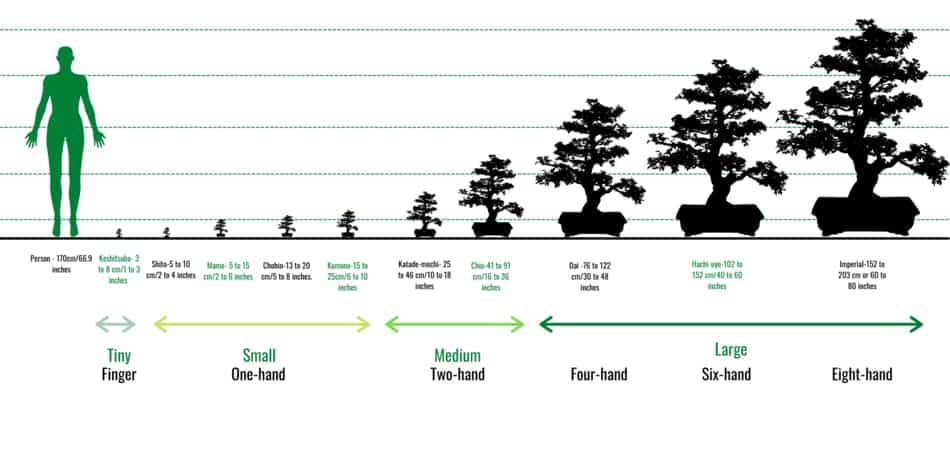
Classification
Size inches
Size Centimeters
Hand Size
General Size
Keshitsubo
1 to 3 inches
3 to 8 centimeters
Fingertip
Tiny
Shito
2 to 4 inches
5 to 10 centimeters
One-hand
Tiny
Mame
2 to 6 inches
5 to 15 centimeters
One-hand
Small
Chohin
5 to 8 inches
13 to 20 centimeters
One-hand
Small
Kumono
6 to 10 inches
15 to 25 centimeters
One-hand
Small
Katade-mochi
10 to 18 inches
25 to 46 centimeters
Two-hand
Medium
Chiu or Chumono
16 to 36 inches
41 to 91 centimeters
Two-hand
Medium
Dai or Omono
30 to 48 inches
76 to 122 centimeters
Four-hand
Large
Hachi-uye
40 to 60 inches
102 to 152 centimeters
Six-hand
Large
Imperial
60 to 80 inches
152 to 203 centimeters
Eight-hand
Large
Classification | Size inches | Size Centimeters | Hand Size | General Size |
Keshitsubo | 1 to 3 inches | 3 to 8 centimeters | Fingertip | Tiny |
Shito | 2 to 4 inches | 5 to 10 centimeters | One-hand | Tiny |
Mame | 2 to 6 inches | 5 to 15 centimeters | One-hand | Small |
Chohin | 5 to 8 inches | 13 to 20 centimeters | One-hand | Small |
Kumono | 6 to 10 inches | 15 to 25 centimeters | One-hand | Small |
Katade-mochi | 10 to 18 inches | 25 to 46 centimeters | Two-hand | Medium |
Chiu or Chumono | 16 to 36 inches | 41 to 91 centimeters | Two-hand | Medium |
Dai or Omono | 30 to 48 inches | 76 to 122 centimeters | Four-hand | Large |
Hachi-uye | 40 to 60 inches | 102 to 152 centimeters | Six-hand | Large |
Imperial | 60 to 80 inches | 152 to 203 centimeters | Eight-hand | Large |
Decide if you will grow your tree from scratch.
Next up is one of the most critical decisions when tuning your almond tree into an almond tree bonsai.
Do you grow your tree from a nut/cutting or get an existing store-bought almond bonsai and train that?
Growing from seedlings/cuttings
Growing your almond tree bonsai from a nut or cutting can easily be one of the most rewarding experiences as a bonsai owner.
This method will give you complete control of your tree, allowing you to design your tree in the exact style you want your tree to grow.
The downside, however, is as almond trees are so slow-growing, they will take a while to reach maturity – if growing directly from an almond.
Most bonsai trees can take 3 to 5 years to reach maturity and 15 years to fully grow and perfect.
If you are patient, growing an almond bonsai tree this way might be the best option.
Buying a store-bought almond bonsai
If, however, you are impatient (like me) and want to speed up the process of designing a bonsai tree, I recommend buying a young store-bought tree that is already a few years old.
This will save you a lot of time in the trunk development stage and allow you to move straight into the development of the branches of your tree.
What’s even better is if you are happy with how the store-bought almond bonsai tree looks, then all you will need to do is maintain the size and style of the tree through regular pruning.
The downside is that store-bought trees can be more expensive, so if you need more money, consider growing that from scratch.
Invest in suitable potting soil.
Next, we need to pot your almond bonsai tree/seed.
As such, the essential material will be the correct potting soil.
Regardless of the bonsai tree species, potting soil must allow moisture to flow through quickly, provide excellent aeration, and retain moisture to ensure your tree does not dry out.
The best potting soil for deciduous species such as almond tree bonsai would be an inorganic mix of akadama and volcanic ash.
Best soil mix for almond bonsai
A good ratio would be the following:
50% akadama, 25% volcanic ash lava rock, 25% pumice.
The potting soil must also be neutral between ph levels 6.5 to 7.5.
Having potting soil that is too acidic or alkaline with potentially impact the nutrient flow of your almond tree bonsai
Now, if you only have organic soil, cactus soil is a good mix, which works surprisingly well as potting soil for all bonsai.
To read more on bonsai tree potting soil, check out my post here.
Repot or plant your almond tree bonsai
Now comes the most challenging part of creating a bonsai from an almond tree.
Repotting/planting are similar but have their unique parameters that need to be sought out, so let’s explore these individually below:
How to plant an almond tree bonsai
Planting an almond tree bonsai is the method you will follow if you are growing your almond tree bonsai from scratch (from an almond)– to find the whole process, check out my post on planting a bonsai tree here.
To summarise, however:
Select your cutting or seedling.
First, decide if you will plant your almond tree bonsai from a cutting or a seed.
Using cuttings
If you use a cutting, make a clean cut at a 45-degree angle and remove any large leaves or excess branches.

Using seeds
If you are planting from a seed/nut, you must get the correct seeds from a reputable retailer or treat the almond seeds you are looking to grow first.
To treat the almonds, pick the almonds that are on the tree and have not fallen into the topsoil.
Lightly hammer these almonds with a hammer so the flesh of the almond breaks.
Soak them in 24 hours, and they should be good to plant.
The good news with most almonds is unlike cold or warm stratification, almonds can be planted at any time of the year.
Gather your pots
Next, it is time to gather the pot you will plant your almond or cutting in.
The pot size will depend on the size of your cutting or seed.
If you are growing from a seedling, using a pot with about 15cm or 6 inches of depth will be ideal.
If you are growing from a cutting, then using a larger-sized pot, such as a large yogurt pot, works surprisingly well.

It’s essential that whatever size pot you decide to use, it has plenty of drainage holes for the size of your seed or cutting.
Hopefully, the table below will help:
Classification | Size inches | Number of penny-sized holes | Number of pencil-sized holes |
Keshitsubo | 1 to 3 inches | 1-2 | 0 |
Shito | 2 to 4 inches | 1-2 | 0 |
Mame | 2 to 6 inches | 2 | 2 |
Chohin | 5 to 8 inches | 2 | 2 |
Kumono | 6 to 10 inches | 2 | 2 |
Katade-mochi | 10 to 18 inches | 2 | 3 |
Chiu or Chumono | 16 to 36 inches | 2 | 4 |
Add your soil mix.
We discussed the best potting soil mix earlier, so put your potting soil into your pot of choice at this stage.
Ideally, this should be around 3 inches deep or about 9cm for the bonsai process.
If you are planting from seed, you can plant your almond in the potting soil.
If plating from a cutting, you must follow the next few steps.
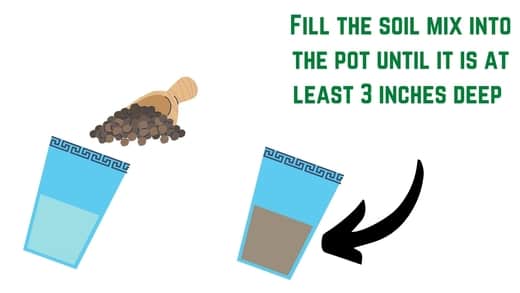
Prepare your almond bonsai cutting to be planted.
If you are using a cutting from an almond tree branch to grow an almond tree bonsai, it is super important you follow this step.
Before the almond tree branch grows in the potting soil, we must prepare it.
To prepare your almond tree cutting for bonsai, start by carving a 1mm deep grove on the bottom of the cutting – this will act as a guideline.
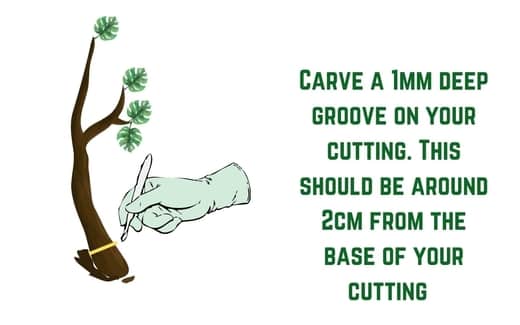
Then depending on the size of your cutting, remove the bottom a few mm/cm from the cutting – in this example, we will use a relatively large cutting, so we will need to remove the bottom two cm.

Then peel back this bottom section of your cutting, removing the cambium until the white inner wood of the cutting shows.
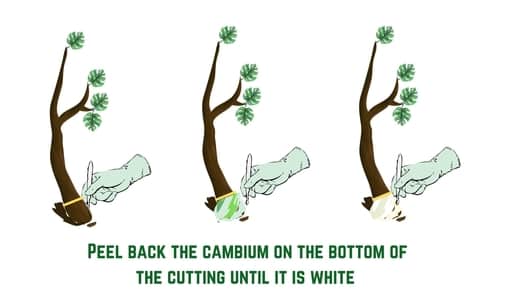
Apply a small, even layer of rooting powder to the exposed spot – this will allow and help your cutting propagate on the soil.
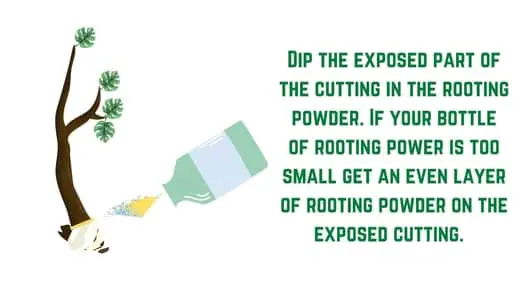
Then, attach a copper wire to the bottom drainage hole and plant the cutting in the pot. Tie this wire around the cutting to ensure it does not move.
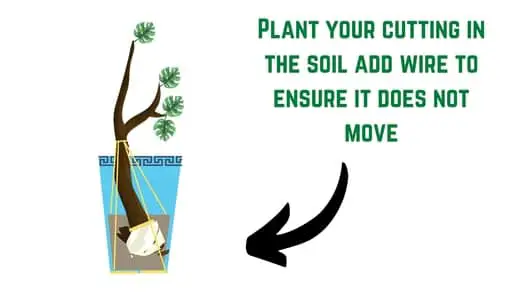
Finally, tightly pack the potting soil so there are no air holes that the cutting can move around in.
Keep in a propagator and maintain the temperature.
So now your seeds/cuttings are planted, the next few weeks will be vital to growing your tree from scratch.
As such, one of the best things you can do at this stage is to keep in an environment where you can control the temperature.
Growing the seeds/cuttings in a propagator or greenhouse where you can control the temperature will be vital.
When trying to sprout almond seeds/roots on the cuttings, the best option will be to keep them at around 60 degrees Fahrenheit (16 degrees c) for the first few weeks, ensuring that you water them daily, keeping the top few cm of topsoil moist but giving it time to dry out in between watering sessions.
Then after about four weeks or so, increase the temperature to about 70 degrees and repeat the watering process for another four weeks.
By this point, new roots/growth should have occurred, and it will be time to ease these cuttings/seeds outdoors.
Ease the new bonsai into its new environment.
Once your seedlings/cuttings have grown, it is time to ease them into their new environment.
Start then by keeping the seedling in the shade for about one week.
The week after, ensure your seedling/cutting gest about three days of direct sunlight and four days in the shade.
One week after that, allow your seedlings/cuttings to rest, as they will be strong enough to grow by themselves.
Maintain and let the seedlings/cuttings grow.
At this stage, you will have a very immature seedling cutting that you can start the bonsai process.
As such, let your tree seedling/cutting grow over the next two years without repotting.
At this time, you will strengthen your tree by watering regularly (checking the topsoil daily to see if it is dry), checking for pests and fungal infections, maintaining its temperature, and regularly caring for the tree.
After a few years, your tree will be ready for repotting.
Repot your almond tree bonsai.
Now if you have decided to go for a store-bought almond tree bonsai Or the seedlings/cuttings you have planted have matured – the next step to growing an almond tree bonsai will be repotting.
Younger almond tree bonsai can be repotted every 3-4 years, with older almond tree bonsai only needing to be repotted every 5 to 8 years. This is because almond tree bonsai is a slow-growing tree species making them ideal for indoor bonsai.
Similar to plating an almond tree seedling/cutting, repotting a bonsai tree is an exhaustive process all in itself, so I would recommend checking out my post here; however, to summarise:
Select the right pot.
You will move your tree from a small shallow pot it is in now to a larger pot with ample room for more root growth.
Aim then for a pot around 80% the size of the widest point in the tree’s canopy.
You can also refer to the table earlier in this post to measure the size of your tree and the number of drainage holes your tree should have.
Remove your bonsai from its existing pot.
Next up, remove the bonsai tree from its existing pot.
Go around the edges of the pot your bonsai tree is in with a root hook.
This should loosen up some topsoil and make it easy to pull out your tree.
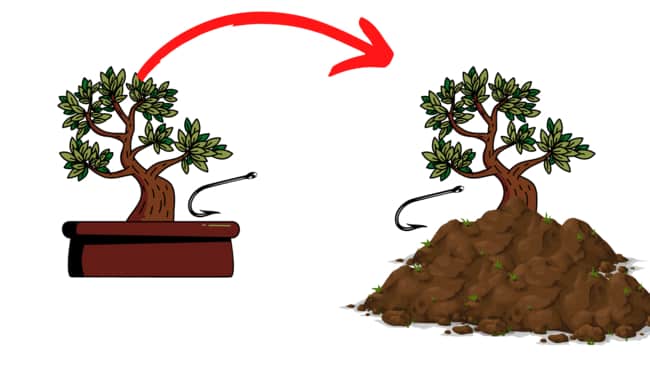
Remove the soil using a root hook.
Next up, we need to access the roots of your bonsai; however, there will likely be a lot of soil surrounding it.
If this is the case, use the root hook to remove some excess soil.
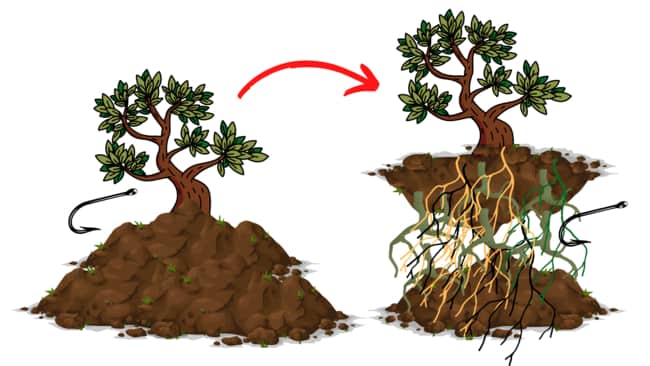
Cut any excess roots.
Now remove and cut any excess roots that your tree has.
Reducing some of the more extensive roots and the smaller feeder roots.
Your bonsai should then be ready for its new pot.
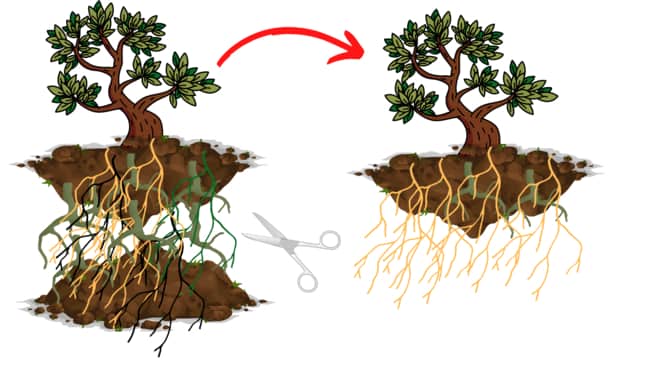
Prepare your drainage holes.
The next step is to prepare the drainage holes in the new bonsai pot.
To do this, cover the holes of your bonsai pot in drainage mesh, preventing soil from falling out.
Then attach a 2mm wire and apply a loop to hold the mesh.
Easternleaf has a brilliant video on this. You can check it out here.

Add wire to secure the tree.
Before you place your bonsai in the new pot, it is essential to add wire to secure the tree in place.
Use copper or aluminum wire and loop this through your pot’s bottom drainage holes and mesh.
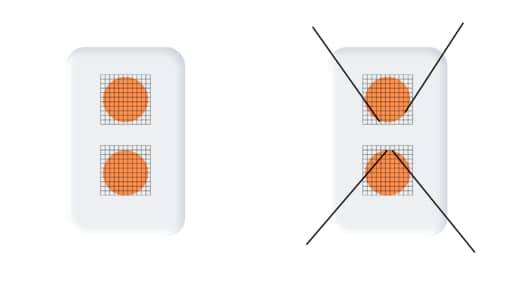
Add a base layer of potting soil.
Now that your pot is prepared, add a dusting of the potting soil mix we discussed earlier.
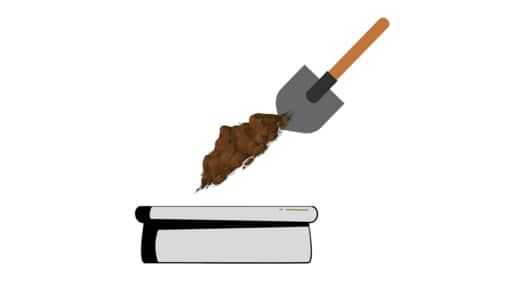
Place your tree in the pot at a front-facing angle.
Then, place your bonsai tree in the pot at the most aesthetically pleasing angle.
Using the copper wire secure this tree in place so it does not move.
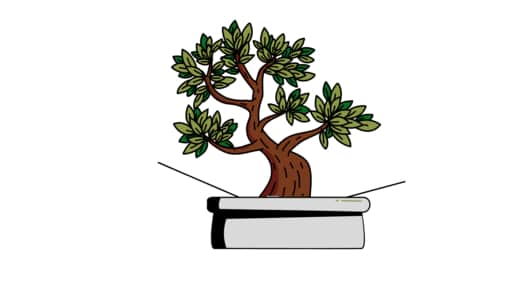
Finish by adding potting soil.
Finally, finish repotting your almond bonsai tree by adding the remainder of the potting soil.
Ensure that no gaps in the soil or air bubbles can cause your tree to dry out.
Master the aftercare process.
Finally, similar to planting a cutting/seedling, it is crucial to master the aftercare process of regular watering, fertilizing, and placement of your new almond bonsai tree.
Again, it is an entirely different topic, so definitely check out my post here.
Alternatively, I’ll touch on these requirements later in the post.
Move your almond tree into the right environment.
We touched upon this earlier, but once you have successfully repotted your bonsai tree or started the growing process from a cutting/seedling, you must move your almond bonsai tree into position.
One of the most significant benefits of almond bonsai is that they are incredibly versatile and do well in indoor and outdoor conditions.
As such, they should be placed indoors, near a window where they can get plenty of direct sunlight (up to 8 hours per day during the summer), or outdoors in the bright spot in your garden.
As almond trees naturally grow worldwide, these conditions would be best for them.
In winter, keep these trees in a cold spot in your house, such as a garage, to prevent them from getting cold-related injuries.
According to the USDA, these plants naturally thrive in hardiness zones 8-10, so keep that in mind depending on where you live.
Develop the trunk of the almond bonsai.
Once your tree has been repotted, the training process can begin.
Training a bonsai will transform your regular-looking bonsai into a more visually pleasing style.
If, however, you are happy with how your tree looks, you can leave it as it is.
The first step to training a bonsai is to develop the trunk of your tree.
Most bonsai trees have very different trunk styles.
For example, sumo bonsai trees have short thick trunks that gradually taper.
Cascade bonsai, however, have thin-sized trunks that change.
To train the trunk of your almond bonsai then, the three things you will need to keep in mind are:
- How to thicken up the trunk of the tree
- How to add a taper to the trunk
- Where to add bends to the trunk of the tree.
The best way to achieve these then is by doing the following:
- Growing out a sacrifice branch – this will add a lot of thickness over the trunk of your tree – grow out a branch of your tree for 3 to 5 years untouched.
- Bonsai trunk chopping – will add a significant amount of taper to the tree by chopping off the top part of your trunk.
- Removing part of the trunk – this will make it easier to add bends into the tree.
Now like a lot of things in this post), bonsai trunk development is a topic all onto itself, so to read up more about how to train the trunk of your almond tree bonsai – check out this post here.
Just keep in mind, however, that as almond trees are slow-growing, it can take between 5-8 years to achieve the desired trunk look you want to achieve.
Wire your almond bonsai tree.
Once you have developed the trunk of your almond tree over a few years – the next step in training an almond tree bonsai will be to wire the branches of your tree.
Wiring the branches of your almond tree will allow you to create movement in the branches, making your tree look more visually appealing, truly mimicking a miniature tree.
To wire an almond bonsai tree, then:
Remove any excess foliage.
Almond tree bonsai leaves are usually relatively small, but they can overgrow.
Removing some of these leaves will make the wiring process easier.
Use a sharp pair of shears and remove any excess leaves.

Select the correct wiring.
Copper wiring is the best choice for almond tree bonsai.
Almond trees can have relatively thick branches, so the copper wire will perform better than aluminum, which can be brittle.
Ensure the copper wire is about 1/3rd the size of the branches you want to wire.
Cut your wire to size. Aim for this to be about 30% bigger than the branch size you will be wiring.
Wire your almond bonsai.
Next up, wire your bonsai.
This can either be done through single wiring or double wiring.
Single wiring
Single wiring is undertaken when you wire a single branch with one piece of wire.
To do this, wrap the wire around the trunk of your almond tree and then wire the branch at a 45-degree angle.
Then repeat this process on the secondary and tertiary branches.
Repeat this process for the other branches that need to be single-wired.
Single wiring can work better on smaller, thinner, and weaker branches.

Double wiring
To double wire, wire two branches next to each other with the same wire.
Wrap the wire around the tree trunk and then wrap it on the more substantial higher branches before moving to the lower branch.
This method works well when you need to add significant movement in the tree, or your branches are powerful.
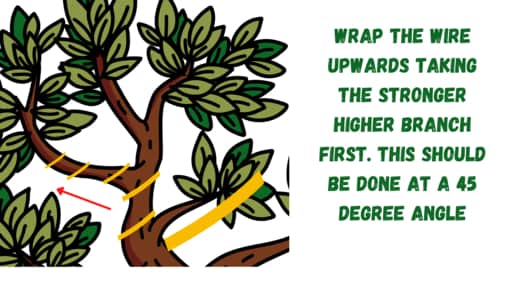
Move branches into position.
Once your tree has been wired, move the branches into position.
The best wait to do this is to use your thumb and index finger on the points where the wire caused the almond tree.
You will require a thicker wire if the branch returns to its original position.
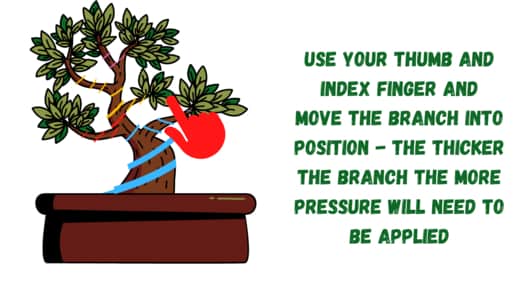
Remove the wire
After 6 to 8 weeks, you can cut the wire from your almond tree bonsai.
Do not unwrap this by hand, as it can cause further damage to the tree.
Wiring an almond tree will take 6 to 8 weeks which will be longer than other plant species due to the speed at which the tree grows.
Prune the tree
The next step in creating an almond bonsai is regularly pruning the tree.
Pruning an almond bonsai tree will prevent growth from getting too big on your tree, and it is vital to keep a clean-looking tree that falls into the exact size classification you like.
This process is simple enough; ensure that if any leaves or branches go out of the general silhouette of the tree style you are going for, these are pruned.
To prune, use a sharp pair of bonsai shears or scissors and cut the branch at the base of the leaves at the petiole of the tree.
If you are unhappy with how dense the canopy of leaves is for your almond tree bonsai, consider defoliating 80% of your almond tree bonsai leaves.
This will cause more leaves to grow from the buds of the leaves you have just pruned, creating a denser, thicker leaf canopy.
When removing the leaves, it is essential not to make one giant cut across multiple leaves but to cut each leaf individually; doing this can cause some irregular growth and damage the leaves.
Stay calm, however, as branches and leaves will be vital for overall bonsai health, such as through photosynthesis.
Repeat the process
So the steps we talked about above will cover the first ten or so years of growing an almond tree bonsai.
Growing a bonsai tree, however, is a challenging process, so you will likely have to repot your tree, wire your bonsai and prune your tree regularly to achieve the desired look and style for your almond tree.
To summarise:
-
Repotting should be done ideally every 3 to 4 years when young or 5-8 years if you have an older tree.
-
Wiring should be done once per year once the almond tree has matured. Wiring can be started in the late winter/early spring to make the most of the tree’s growth season.
-
Pruning should be done whenever the tree growth gets beyond the silhouette of the style of the tree you have in mind – think of it as trimming a hedge.
-
Defoliation should be done roughly once per year – only during the early spring.
In total, then, creating an almond bonsai tree can take decades to achieve, but following these steps will work wonders!
Advantages of an almond tree bonsai
Almond tree bonsai has several advantages, including:
- Water requirements – While these trees will still need to be watered, they often do not need to be watered as much as other bonsai species. Watering once per day should work.
- Clean the air – Should you keep your almond bonsai indoors, it can help with purifying the air
- New roots – almond trees bonsai can easily create new roots, making it much easiest to create deadwood such as nebari.
- Longevity – almond tree bonsai comes from almond trees that can live for thousands of years if cared for properly.
- Fruit-bearing – almond tree bonsai can also produce almonds
- Can be grown indoors – making them ideal for tight spaces such as apartments.
Disadvantages of almond tree bonsai
Like all tree species, almond trees also have many significant disadvantages.
These include
- Slow growing – almond tree bonsai typically only grow a few inches every year, meaning they can take a while to shape
- Tough wood – almond tree bonsai has tough wood meaning stronger copper wire has to be used when wiring – this is more likely to lead to breakages in the bark.
- Harsh winters – almond tree bonsai need to be kept indoors during cold winters, or else they will die.
- Sunlight requirements – these trees require a lot of sunlight. If you keep these indoors for years, their health will suffer.
Almond bonsai care requirements
Now I’m sure many of you still have questions about the exact care requirements for almond tree bonsai.
Hopefully, the following few points should help clear up any additional queries:
Temperature requirements for almond tree bonsai?
The best temperature to keep an almond tree bonsai in is 0-95 degrees Fahrenheit (-12 to 35 degrees Celsius). Should the temperature drop below this, the bonsai will freeze. Should temperatures exceed this, almond bonsai will burn.
How fast does almond tree bonsai grow?
Almond tree bonsai is a slow-growing tree, only growing on average between 5 to 12 inches per year. This means it can take 15 years for the tree to reach full maturity if growing an almond tree bonsai from scratch.
Water requirements for almond tree bonsai?
Almond tree bonsai typically must be watered once daily in the summer and twice weekly in the winter. Touch the topsoil. If dry, water the tree thoroughly from top to bottom.
Almond trees that are not in bonsai form only need to be watered about once per week; however, the process of turning the almond tree into a bonsai will mean the tree will require more water.
Sunlight requirements for almond tree bonsai?
Almond tree bonsai require between 6 to 8 hours of direct sunlight in the summer and 4 hours in the winter. Ensure these trees are kept in a bright spot with plenty of sunshine.
Where to place an almond bonsai?
The best place to keep an almond bonsai tree will be outdoors in the brightest spot of a garden or yard that gets plenty of direct sunlight. Almond tree bonsai can also be kept indoors, provided they are in an area with sunlight, such as a kitchen window sill.
How long does it take to train an almond tree bonsai?
It can take between 15 and 20 years to successfully train an almond bonsai to a specific style if growing from scratch. This is because the process of trunk development and growth can take a few years, and almond trees are a slow-growing species.
Wiring and deflation can be archived relatively quickly.
Fertilizer requirements for almond tree bonsai
Almond tree bonsai requires solid organic fertilizer once per month in the spring and summer months. Fertilizing an almond tree bonsai should be avoided in the fall and winter. Liquid fertilizer can be used once per week.
How often should you repot an almond tree bonsai?
Almond tree bonsai should be repotted once every 3-4 years if they are younger and smaller. Older almond trees that are more than 20 years in age can be repotted every 5-7 years.
Almond tree bonsai care in the summer
During the summer, the following should be undertaken to care for the almond bonsai as best as possible:
- Check multiple times daily for water requirements – if the topsoil is dry, your tree will need watering. Aim to check the topsoil during the summer at least two times per day.
- Keep in the shade – while the almond tree bonsai will need up to 6 to 8 hours of direct sunlight, keeping your tree in your garden can be the best option to give a low dose of UV light year-round. This will also help prevent your tree from burning should it get too hot.
- Check for insect infestations – pests such as aphids and spider mites love almond tree bonsai due to their fruit, so keep an eye out for these during the summer.
Almond bonsai care in the winter
To care for an almond tree in the fall or winter take, do the following:
- Remove any almonds from the tree – during the fall. Almonds will start to grow on the tree; ensure you remove these to prevent pests such as foxes, squirrels, mice, rats, and birds from attacking your tree.
- Move your tree indoors – a cold garage works if you live in a place with a harsh snowy winter.
- Water once per week – during the winter, almond trees do not need to be watered as much – too much watering can cause the tree to freeze and can create frost on the tree.
Survey reuslts
Finally, I quickly surveyed plant paladin readers who owned almond tree bonsai and asked them if it is challenging to grow and train an almond tree bonsai.
Here are the results:
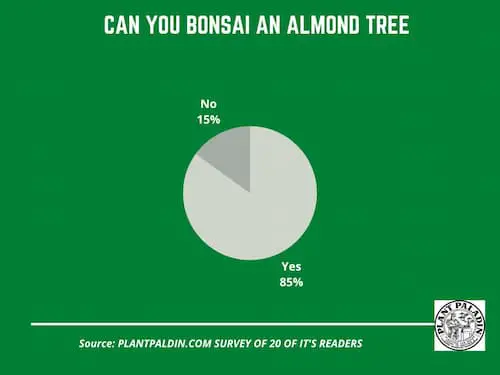
My top picks for the gear you will need!
So like I mentioned earlier, over the past three years of running PlantPaladin, hundreds of people have asked me for my recommendations on the best bonsai gear on the market.
Having spent thousands of dollars on bonsai items these past few years and tested at least 100 bonsai-specific products, I’ve listed my favorite products below – All of which I highly recommend and think you can get great value.
They can purchase directly by clicking the link to take them to Amazon.
Bonsai Tool Set: One of the significant challenges I’ve had is finding a toolset that was not only durable but didn’t break the bank. SOLIGT has recently developed a fantastic bonsai tool set that covers all the tools you need to trim, prune, and repot your trees. – You can grab it here.
Complete Bonsai Set: Many of you will want to grow your bonsai trees entirely from scratch, but finding the varicose seeds, pots, and other items in one place can be challenging. Leaves and Sole then have created a complete bonsai set that I’ve personally used that ticks all the boxes. You can grab it here.
Bonsai wire: The number of times I’ve run out of wire for my bonsai or purchased cheap bonsai wire that doesn’t do the job is embarrassing for me to admit. After a lot of trial and error, I found that using Hotop’s aluminum bonsai wire is one of the best options on the market. This can easily be used for both indoor and outdoor bonsai. You can grab it here.

